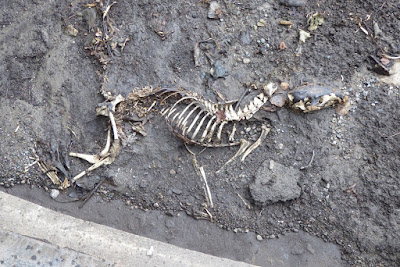A few weeks ago I ordered from Amazon a 100A ammeter. We are currently (oops!) on the boat having got here two days ago. Yesterday I had a go at connecting up the current shunt and digital display.
Ideally I would like to be able to see how much current is flowing into or out of the domestic battery bank; I know that these meters need the shunt to be in the negative lead and that they work in one direction only. I have an idea for how to deal with this later, but for now I wanted to see if the device would work.
As soon as I lifted the lid on the battery compartment I realised that things were not going to be straightforward. Some of the negative connections, from the alternators, for instance, I think go directly to the engine "earth". And there was the massive cable going to the inverter. Do I try to put the shunt in the way of this? The inverter is a 3kW jobbie; at full output it could draw at least 3000 / 12 = 250A, so my 100A shunt would get all hot and bothered. Plus the display would merely indicate overcurrent.
I bolted the shunt to a spare short battery lead from the negative of the battery bank and connected all the negative leads apart from the inverter to the other end of the shunt. I say "all" - there were, in fact, just two leads. One was the negative connection to the 12V distribution busbar; the other connected to the engine block. Then I connected the three small leads from the display unit - one to +12V and the others either side of the shunt.
I found the display reading the battery voltage more or less correctly (overreading by 0.2V) and displaying 0.0A. Then I switched on all the lights to see if the reading changed but it didn't. (That's LED lighting for you - I should have switched on the tunnel light!) I guessed I had wired the display for current going in the other direction but I had run out of time to see if it measured a charging current as we had promised Ally and Ben some help at their house.
Today I had another go, swapping round the current sensing wires and connecting only the 12V distribution negative. Mistake! This is how it looks now.
The current shunt is a bit difficult to make out as it is black over the black battery. It runs top to bottom of the photo; the top thick black cable goes to the main battery negative terminal and the bottom thick black cable goes to the 12V distribution. The thin blue and green wires are fixed to the shunt with small screws.
This is the display. The wires coming out of it are only a few centimetres long, hence the different colours at the other end.
The mistake I made was to not connect the lead to the engine block to the shunt (I had reconnected it to the main battery negative). When I checked the display again it showed 0.2A when the water pump ran, but the reading jumped between 0.2A and 0.4A in an apparently random manner.
Tomorrow I shall have to connect up the engine block lead and see if I can register any charging current.
My solution to the only-reads-one-way problem will be to add a simple changeover switch in the current sensing wires. Then I should be able to see the charging current when the batteries are charging and the load current when not charging.
Sorry this is a bit rambly!








































































